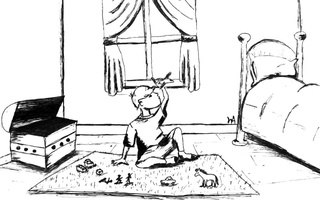Emma Donoghue does not equivocate about the sort of book “Frog Music” is supposed to be. It opens with the murder of Jenny Bonnet, shot through the window of a boarding house near a 19th-century San Francisco train station. From the protagonist Blanche’s gaiters to the quirky French lullabies she and Jenny sing, Donoghue spares no detail in establishing the period setting, and she waits only a few pages to introduce the murder mystery that motivates the novel. At no point does she attempt to delude the reader into thinking he or she is reading a solemn or profound work of literature: “Frog Music” is a suspenseful mystery novel set in 1870s California, and a very accomplished one at that. Donoghue focuses on and develops those elements that most effectively propel her story—specifically, her characters, setting, and manipulated chronology—and crafts a gripping read, the sort of 400-page novel one might very well finish in a single sitting.
By commencing the novel with Jenny’s murder—a wise choice in that it immediately engages the reader—Donoghue has confined herself to utilizing a nontraditional chronology to explain the events that precipitate Jenny’s demise alongside the effects of the event. She thus proceeds along two separate timelines, alternating sections of each throughout the book. One proceeds from Blanche and Jenny’s first encounter, and the other details Blanche’s life following Jenny’s death. By juxtaposing these two storylines, Donoghue is able to reveal bits and pieces of the overall trail while simultaneously introducing additional mystery, a technique that maintains the book’s suspense throughout its length. While the alternating plotlines might have become confusing in the hands of an inferior writer, Donoghue executes the transitions deftly, such that the reader never loses track of either thread.
Within this scaffold, Donoghue crafts a cast of distinctive and often powerfully sympathetic characters who constitute the novel’s emotional core. Jenny, the cross-dressing, bike-riding frog catcher, is immediately likeable, but it is the surprising protagonist, Blanche, who most effectively captures the reader’s sympathy. She is a dancer and a prostitute, a fact that Donoghue makes clear from the novel’s very beginning; simultaneously, Blanche is so likeable and emotionally resonant that she would easily overcome any associated prejudices a reader might have to become an unequivocally successful protagonist. Donoghue achieves this connection between protagonist and reader most effectively through her portrayal of Blanche’s relationship with her son, whom she rescues from an abhorrent “baby farm” and who is later stolen from her shortly before Jenny’s death. Her reaction to the baby farm is particularly moving, as when she dreams “she was back in that house on Folsom holding a pillow and running from crib to crib, pressing it down on each face, leaning hard, snuffing out these abominable half-lives.” This uncomfortably realistic reaction to the situation in which Blanche found her son, as well as their developing closeness and the brutality of their separation, all serve to render Blanche in a potently sympathetic light. She becomes a particularly effective protagonist because she is, ultimately, so human.
But a likeable protagonist alone cannot carry a period mystery, and where “Frog Music” truly shines is in its nuanced, impeccably researched depiction of 1870s San Francisco. Donoghue depicts the city during both an oppressive heat wave and the peak of the smallpox epidemic, and in representing each she conveys the extreme pressures they exerted on the people who suffered through them. She describes one smallpox victim as having “hands…embroidered with huge rubies each half an inch across, globes so thick on his right lid that he can’t open his eye.” Blanche wonders if he will “burst apart in the end, dynamited from inside his own skin.” Even before any major character is afflicted with the illness, smallpox looms ominous; in her vivid description of the character who eventually contracts it, Donoghue represents the terrifying impact of the disease on the San Franciscan population. In other facets, too, Donoghue paints an immersive and realistic setting, from the fragments of French spoken by Blanche and others throughout the novel to the snatches of songs she periodically includes. She has clearly devoted an enormous amount of time to researching her novel, and her efforts pay off fabulously in the entrancing setting she is able to craft.
Thus, though “Frog Music” will not necessarily help Donoghue win the Nobel Prize in Literature, she has still created an absolutely successful period mystery. “Frog Music” is engaging, consistently suspenseful, and compelling; though an undemanding read, it is nevertheless deeply affecting, particularly on account of the sympathy the main characters demand. From its first few pages, “Frog Music” engages readers completely and immerses them in its beautifully detailed, well-developed world.
Read more in Arts
Shimabukuro Wows at Ukulele WorkshopRecommended Articles
-
Harvard Night at the HollisTonight is Harvard Night at the Hollis Theatre. The presentation of the evening, under the direction of Sam K. Harris,
-
 Donoghue Takes on the Voice of a Child in ‘Room’
Donoghue Takes on the Voice of a Child in ‘Room’ -
 Harvard Houses Welcome Freshman Class
Harvard Houses Welcome Freshman Class -
 Donoghue’s Historical Latest a Mixed Collection
Donoghue’s Historical Latest a Mixed Collection -
Club Sports Hit By Funding CutsWith the Undergraduate Council’s budget constrained and its ability to fund student organizations increasingly limited, some club sports groups on campus have received less UC funding this year than expected and have had to make spending cuts or raise fees to adjust.














